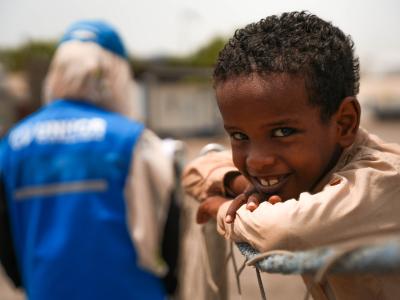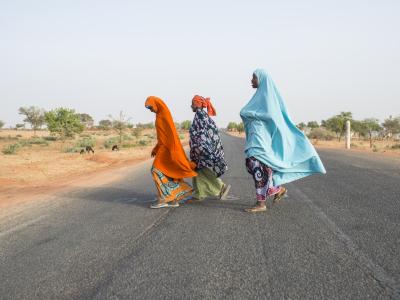People can only realize their rights in a safe environment if they find safety and security, protected against the risks of arbitrary detention, gender-based violence, trafficking in persons and many other violations and dangers. They also need at least to have the very basics required for a stable life: a roof over their heads, a safe and warm place to sleep, a working toilet, access to health care, enough food to keep hunger at bay, and sufficient supplies of clean water and fuel.
2023 saw a peak in the number of displacement emergencies declared by UNHCR, and although the Office was able to assist millions with core relief items, cash and shelter, the vast disparity between what was needed and what was available grew wider.
This was evident from the spike in the numbers of forcibly displaced and stateless population, the record size of UNHCR’s budget that aimed to meet their needs, and the unprecedented shortfall in funding, leaving half those needs entirely unmet. The lack of funding affected the entire humanitarian sector, not only UNHCR. WFP, for example, was forced to cut rations for the people it was trying to support, including refugee populations.
Greater investment and targeted action supporting full socioeconomic inclusion is needed to reduce the number of forcibly displaced and stateless people living below the poverty line.
While official data on poverty is limited, sources such as the 2023 GCR Indicator Report show that refugees and other vulnerable groups were disproportionately affected by the COVID-19 pandemic and at a higher risk of poverty relative to nationals. Indeed, in countries where official poverty data exists, the likelihood of refugees being poor compared to nationals varied greatly. In Chile, the poverty rate was 5% higher among refugees, but in Ethiopia and Uganda the poverty rate among refugees was more than double the rate among nationals.
The risk of refugees falling into poverty is minimized when host countries provide a more conducive policy environment allowing for freedom of movement, formal employment and access to social services. Efforts to ensure that refugees and other forcibly displaced people are included in national statistical exercises are leading to additional reliable and comparable poverty data.
For instance, the World Bank’s poverty assessment in the Central Africa Republic provided a deeper understanding of the situation of IDPs as well as a roadmap for the Government and other development partners to address poverty and solutions to internal displacement.
Similar efforts to incorporate refugees and other forcibly displaced people in government-owned, nationally representative household surveys measuring poverty are ongoing in other countries, including Ethiopia, Mali and Uganda.
At a minimum, refugees and asylum-seekers need to reside in physically safe and secure settlements with access to basic facilities. In 2023, in about 60% of the 86 countries where UNHCR operations reported such data, more than 75% of refugees and asylum-seekers did reside in such settlements. However, only six of the 24 countries reporting such data on internally displaced people reported that more than 75% of IDPs resided in physically safe and secure settlements.
In many countries, instead, forcibly displaced and stateless populations live in highly climate-vulnerable areas.
UNHCR operations also reported data on housing conditions. Data from 39 countries reporting data on refugee housing and 18 reporting on housing conditions for IDPs showed a modest improvement for both population groups, with 39% living in habitable and affordable housing.
UNHCR operations reported data on health services in 99 countries in 2023, and over 75% of refugees and asylum-seekers had access to health services in 75 of those countries.
Data from the Standardized Expanded Nutrition Survey (SENS) in 2023 from 117 refugee settlements across 18 countries (mostly in Africa) showed various forms of malnutrition persisted among the refugee population. The prevalence of global acute malnutrition (GAM) was 10%, indicating a serious situation, and prevalence of stunting, the chronic form of malnutrition, was 30%, indicating a critical situation.
Refugee children in emergency situations experienced even higher levels of malnutrition, such as in the Sudan situation, where 1 in 3 children were affected by acute malnutrition.
Financial overview
Budget and expenditure
-
UNHCR’s 2023 budget for this Impact Area was $5.236 billion, or 50% of programmed activities.
-
The largest requirements for this Impact Area were for operations in Ukraine, Lebanon, the Syrian Arab Republic and Jordan.
-
Expenditure of $2.529 billion accounted for 49.0% of total expenditure, a decrease of $555.5 million, or 18%, compared to $3.084 billion in 2022.
Global expenditure and budget for Impact Area "Respond"
$2.529 billion spent against a budget of $5.236 billion
$2.707 billion of unmet needs or 52% of the budget





